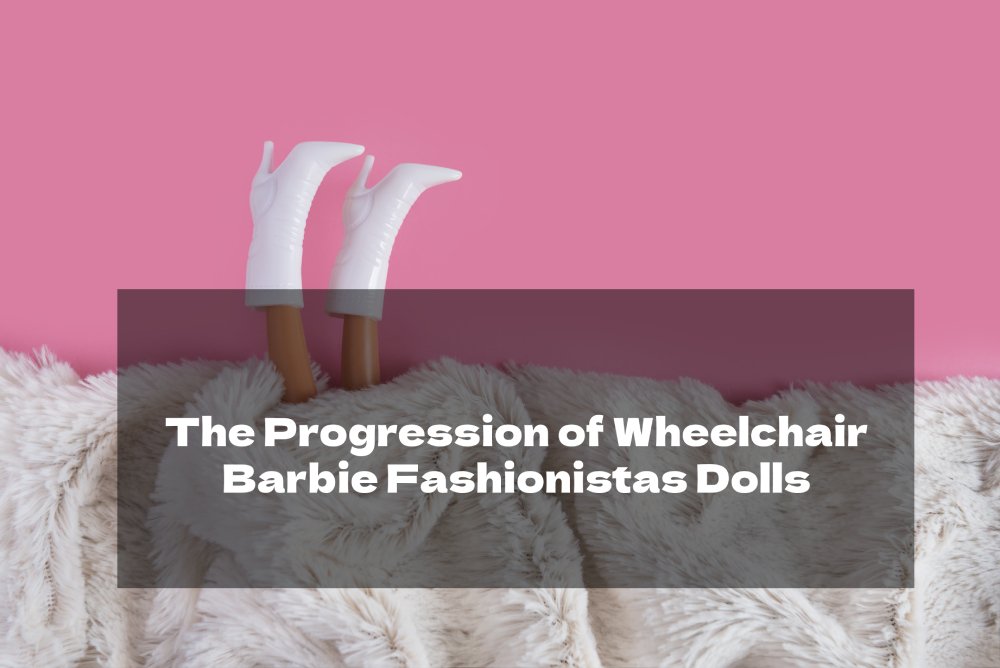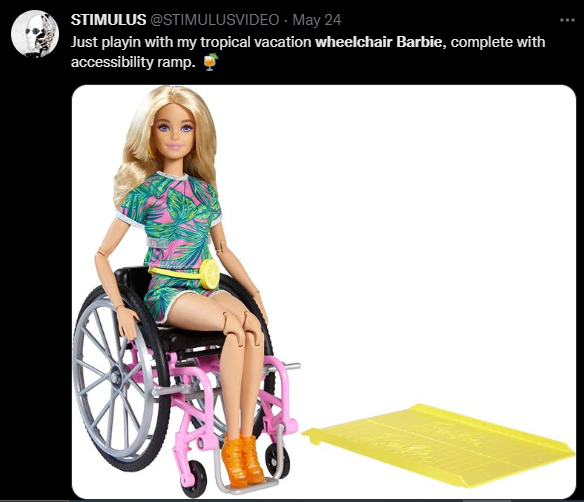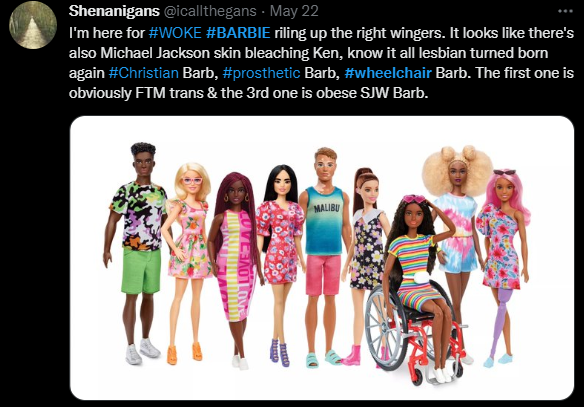Barbie, the iconic fashion doll with long blonde hair, is now six decades old and is a lot different than she used to be.
Barbie and her friends sold over a billion units worldwide and keeps improving as she ages.
Over the years, the barbie fashionistas doll has adapted different hair textures and hairstyles like loose waves, the latest trends, shoes like the orange sneakers skin tones, and career choices to inspire young girls.
She has been an astronaut, an airforce pilot, a surgeon, an Olympic champion, and much more.
She has evolved from the angled feet to be one of the most popular flat shoe fit dolls.
Today, Barbie has over 100 looks to make her as diverse as the kids who play with her. The doll is realistic and has a removable prosthetic leg thanks to Barbie’s new line addition dubbed the Fashionistas.
Mattel, the company behind Barbie, took up these new additions as a direct response to what Barbie fans wanted. In other words, Barbie has come a long way from that skinny, blonde-haired doll in flat shoes 60 years ago to embrace different body types, braided hair textures, races, and disabilities.
In this article, we will look at the progression of the wheelchair Barbie over the years.
Mattel Gets More Inclusive With The Wheelchair Barbie
It has for a long time been the belief by many disabled children that society has either ignored or neglected them.
Thanks to the effort of Mattel, children with disabilities now have their representative toys.
In 1997, Barbie launched a wheelchair doll and a prosthetic doll. These were inspired by Jordan’s story, a 12-year-old child with a prosthetic arm, and are part of Mattel’s 2019 Barbie Fashionistas doll collection.
The launch of Becky was not the toymaker trying to push an agenda about disabilities but a direct response to high consumer demand.
The toymaker worked with a team from UCLA to create the barbie wheelchair and included input from Jordan Reeves, who was brought in to represent disabled people and make the product as realistic as possible by attaching his personal experiences as a person living with a disability.
The request for a Barbie with a realistic wheelchair was high for young people who enjoyed playing with Mattel’s dolls.
To some, it may seem like an insignificant step towards the development of diversity in the toy industry, but for the children living with disabilities across the world, it is long-awaited and significant progress.
A step to encourage real-world storytelling away from the ordinary Barbie fashion dolls with flat feet and in a barbie dream house, we’ve all known.
Despite the toymaker having a production line released as Barbie’s friend named Becky, who used a wheelchair and, to a large scale, appealed to disabled children, the line was discontinued.
The toymaker cited little interest in this doll production line, damaging the company’s profits.
The price of the wheelchair Barbie retailed on Amazon at $59, while the other line of Barbies ranges from $11 to $30. The high pricing of the Becky doll thus made it hard for children to afford them.
Different Types Of Wheelchair Barbies
Ever since Mattel created the first Barbie in 1959, the doll has, over the years, assumed a formulaic guise to be more representative of “real women” and the young people that play with her.
The doll company has continued to make strides and released disabled Barbie dolls in wheelchairs. Mattel included these additions to its Fashionista line in 1997 and named the doll line ‘Becky.’
Mattel hopes that the collection of wheelchair barbies will help broaden its product line and recognize disabled children as an essential part of society.
For the new wheelchair Barbies, the toymaker worked with the UCLA Mattel Children’s Hospital and wheelchair experts. Mattel also worked with Jordan Reeves, a 12-year-old, with her doctor to produce a doll with a removable prosthetic limb.
Here are the three types of wheelchair babies:
-
‘Share-A-Smile Becky’ Barbie Doll
Share a smile Becky is the first doll in the barbie world with a wheelchair and was released in 1997.
It comes with a head sculpt, necklace, blue handbag and earrings, and a pink and purple wheelchair with rolling wheels that children can push her around in.
‘Share a smile Becky’ makes an ideal collection for children over three years to play with.
Kids can use one of her two necklaces and wear it as a bracelet. This creates a fun addition to kids’ set of play toys allowing them to exercise creative play through their imagination.
-
School Photographer Becky
In 1998 another wheelchair barbie followed the school photographer Becky barbie. This barbie came with a more realistic red wheelchair, a teen skipper head sculpt, a camera with a red ribbon strap, a pair of red glasses, a mini yearbook with actual pages, and a backpack.
School photographer Becky has flat Barbie feet and articulated ankles. She has strung hips with elastic joints, a twisted waist, and jointed elbows and knees.
Despite her being handicapped, this blonde, beautiful, fashion-inspired, and collectible Barbie travels to all events in the school with all the Barbie gang and takes pictures for the yearbook.
School photographer Becky even won an award for a picture of the girls’ basketball team.
-
Barbie Becky, Paralympic Champion
Mattel released another Barbie in a wheelchair later in 1999, Barbie Becky paralympic champion. Becky is a Friend of Barbie and is racing for gold at the Sydney 2000 Paralympic Games.
Recommended for 3-8 years, Barbie Becky paralympic champion is dressed in a blue jacket, tank top, leggings, helmet, medal and has a towel, water bottle, and racing wheelchair.
Impact Of The Wheelchair Barbie
The toymaker’s inclusion of the wheelchair Barbie with other dolls, albeit the high price, is fantastic for parents.
Let’s all face it; it is challenging as a parent to bring up a disabled child. With all the stigma and stereotypes surrounding disability, now more than ever, you need society to understand, respect, and provide support for the needs of disabled children.
The wheelchair Barbie has taken steps toward building high self-esteem in disabled children by making them feel that they are an important part of society and that their learning potential can be maximized.
According to CanChild Centre Co-Director Mary Law, some children may face difficulties forming and maintaining healthy relationships with their peers because of disabilities that may restrict or limit them from participating in daily activities with friends. This may have adverse effects on their mental health.
Little girls in wheelchairs can finally have Barbies that look just like them, whether in skin tones or physical ability.
The result is a possible change in the lasting stereotypes in society and so many play possibilities, especially with barbie dream house.
Although we still have a long way to go towards helping children with disabilities, wheelchair Barbies are increasingly allowing the course.
Conclusion
The introduction of the wheelchair barbies was initially met with excitement by a large group of the disabled community, thrilled that Barbie was finally being inclusive.
However, not long after, some of the excitement turned to disappointment and a bit of anger.
This followed the discovery that the wheelchair Barbie could not correctly fit through the elevator or the door to the Barbie dreamhouse. The barbie kitchen also did not have accessible appliances.
Now, I can understand why fans were upset that instead of Mattel reworking the cars, horses, houses, and the rest of the items in Barbie’s world to accommodate the wheelchair, it chose to discontinue the Becky line altogether.
Mattel’s move sent the message that getting rid of the disabled is much easier than dealing with them.
On the other hand, if we look at it realistically, Mattel is a business that has to make a profit to keep afloat.
Therefore, it would have been very expensive to redesign everything else in the Barbie world, considering the sales of the Beckys are lower than that of the other fashionista dolls.
If Mattel ever redesigns parts of Barbie’s house to make it accessible by wheelchair, maybe the company could bring Becky back.




